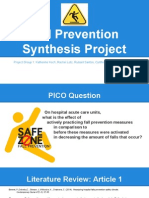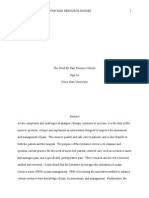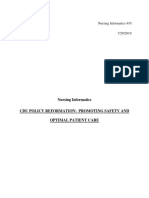Nurs 240 Paper
Nurs 240 Paper
Uploaded by
api-301861602Copyright:
Available Formats
Nurs 240 Paper
Nurs 240 Paper
Uploaded by
api-301861602Original Title
Copyright
Available Formats
Share this document
Did you find this document useful?
Is this content inappropriate?
Copyright:
Available Formats
Nurs 240 Paper
Nurs 240 Paper
Uploaded by
api-301861602Copyright:
Available Formats
Running head: PATIENT SAFETY AND SHIFT LENGTH
Patient Safety and Shift Length
Andrea R. VanPortfliet
Ferris State University
PATIENT SAFETY AND SHIFT LENGTH
Patient Safety and Shift Length
Patient safety is very important in the hospital setting. Patients come to the hospital with
trust that they will be taken care of and get better. It is important that all employees are doing
everything possible to keep them safe and assist the patient in healing. Shift length is one topic
that has been discussed and researched. Are the patients being put in danger when the nurses and
doctors have been there for twelve hours and are exhausted and overworked? The goal is to
reduce the number of handovers, which is thought to reduce the amount of error made in patient
care (Griffiths, 2014). This is an excellent idea in theory, but some studies show that patient
safety decreases as shift length increases.
A normal shift length is eight hours, but the idea is to decrease handovers which is
thought to increase the safety for the patient. A handover is when one nurse leaves for the day
and another takes their place. They will discuss the patients diagnosis and any important
information needed to care for them, such as, ambulation, allergies, and much more. By having
twelve hour shifts, there is only two handovers per day, rather than three with the eight hour
shifts. Handovers can be dangerous when a nurse forgets to tell an important piece of
information to the next nurse on shift. The aim is to improve efficiency with no detrimental
effect on quality, (Griffiths, 2014). Although there are many benefits to the twelve hour shift
system, there is also a downside.
Nurses and doctors working twelve hour shifts are more likely to make more errors and
there is a decrease in patient safety and quality of care. There is an increased risk for infection in
the patients and can result in more injuries to the patient and the nurse, including falls, needle
sticks, and musculoskeletal injuries (Stimpfel, 2013). The quality of care decreases and the safety
of the patient is at risk. Increased fatigue results in unsatisfactory performance and can lead to
more errors. Employees working ten hour shifts or longer report a high level of fatigue nearing
the end of their shifts.
PATIENT SAFETY AND SHIFT LENGTH
A study done by The Association with Perceived Quality of Care and Patient Safety did a
cross-sectional survey of nurses with varying shift lengths, from eight to twelve or more hours.
They were asked how many hours were worked and how they felt their quality of care was for
their patients. Nurses who worked ten hour or greater shifts or overtime reported they had left
care undone or did not meet acceptable patient safety (Griffiths, 2014). Since patient care and
safety is a hospitals main concern, longer shifts and overtime can be damaging to the patient as
well as the hospital.
Nursing Theory
Jean Watsons theory of nursing can closely relate to this topic. The central theme of her
theory is that Nursing is concerned with promoting and restoring health, preventing illness, and
caring for the sick, (Taylor, p. 75). When the nurses reported that they left care undone, and are
not satisfied with their quality of care, they are not meeting this theory. They are not promoting
and restoring health when there is a greater risk for injury. When a nurse or doctor is fatigued
from a long day at work, they are not able to supply the care and respect that is needed to help
the patient heal.
Conclusion
Therefore, shift length of ten hours or longer are thought to be dangerous to the patient
because there is a decrease in the quality of care and safety for the nurse and to the patient.
Although there are less handovers than the eight hour shifts, the study shows that mistakes and
injuries are increased when a twelve hour shift or overtime is worked due to fatigue. In
conclusion, some studies show that patient safety and quality of care is being compromised when
a nurses shift exceed ten hours.
PATIENT SAFETY AND SHIFT LENGTH
References
Griffiths, P., Dall'Ora, C., Simon, M., Ball, J., Linquist, R., Rafferty, A., & Aiken, L. (2014,
October 15). Nurses Shift Length and Overtime in 12 European Countries. Retrieved
from PubMed.
Stimpfel, A., & Aiken, L. (2013, April 28). Hospital Staff Nurses' Shift Length Associated With
Safety and Quality of Care. Retrieved November 18, 2014, from PubMed.
Taylor, ., Lillis, ., LeMone, ., & Lynn, . (n.d.). Fundamentals of Nursing (Seventh ed., pp. 74-75).
Philadelphia, PA: Lippincott Williams & Wilkins.
You might also like
- Childhood Obesity Apa PaperDocument13 pagesChildhood Obesity Apa Paperapi-3018616020% (1)
- Quantitative Article Critique and SummaryDocument8 pagesQuantitative Article Critique and SummaryEmmanuelNo ratings yet
- NFDN 2003 PaperDocument16 pagesNFDN 2003 Paperapi-302133133No ratings yet
- Understanding The Self Study NotesDocument3 pagesUnderstanding The Self Study NotesJojo Takato100% (11)
- Republic of The Philippines Province of Cavite: City of DasmariñasDocument18 pagesRepublic of The Philippines Province of Cavite: City of DasmariñasDaryl De VeraNo ratings yet
- 9. SEQUENCE IMPEDANCES OF 3-Φ TRANSFORMERDocument4 pages9. SEQUENCE IMPEDANCES OF 3-Φ TRANSFORMERBhanu100% (1)
- ResearchsynthesisDocument3 pagesResearchsynthesisapi-308232715No ratings yet
- EBP Shift Length Affects Patient SafetyDocument5 pagesEBP Shift Length Affects Patient SafetyTuTitNo ratings yet
- Powerpoint ResearchDocument29 pagesPowerpoint Researchapi-402806930No ratings yet
- Final Position PaperDocument14 pagesFinal Position Paperapi-425080644No ratings yet
- Group Work Assignment Group 3Document9 pagesGroup Work Assignment Group 3Nduka MmesomaNo ratings yet
- Uswatun Hasanah (713.6.2.0498) ..Document1 pageUswatun Hasanah (713.6.2.0498) ..vindaNo ratings yet
- The Effects of Nurse Staffing On The Medical Surgical Unit Involving Patient Safety and Quality of CareDocument13 pagesThe Effects of Nurse Staffing On The Medical Surgical Unit Involving Patient Safety and Quality of Careapi-402644703No ratings yet
- Preoperative Visit in Nigeria PDFDocument7 pagesPreoperative Visit in Nigeria PDFAlex PiecesNo ratings yet
- Synthesis Project Group Final-FallsDocument18 pagesSynthesis Project Group Final-Fallsapi-290381420No ratings yet
- Hinton - Leadership Paper - Final Draft UpdatedDocument4 pagesHinton - Leadership Paper - Final Draft Updatedapi-435514294No ratings yet
- Group ResearchDocument16 pagesGroup Researchapi-402701741No ratings yet
- AdvocacyDocument2 pagesAdvocacyapi-402048525No ratings yet
- Restraints AssignmentDocument6 pagesRestraints Assignmentapi-284091020100% (1)
- Kholifatur RahmaDocument1 pageKholifatur RahmavindaNo ratings yet
- Andrews Haegele ChurchillDocument2 pagesAndrews Haegele ChurchillCloretta SingletaryNo ratings yet
- Nurs 440 LeadershipstrategyanalysisgrouppaperDocument10 pagesNurs 440 Leadershipstrategyanalysisgrouppaperapi-253019091No ratings yet
- Running Head: CALL FOR ABSTRACT 1Document5 pagesRunning Head: CALL FOR ABSTRACT 1api-393877273No ratings yet
- Approach To Nursing Assessment 1Document5 pagesApproach To Nursing Assessment 1Taiye OkondoNo ratings yet
- Synthesis Paper J.RepinDocument4 pagesSynthesis Paper J.Repinjrepin0225No ratings yet
- Nursing and Patient Safety in The Operating RoomDocument10 pagesNursing and Patient Safety in The Operating RoomJoe AbelloNo ratings yet
- 2 Devpria.... Ruks... GuruDocument7 pages2 Devpria.... Ruks... GuruLorenaNo ratings yet
- Quality and Safety Synthesis PaperDocument6 pagesQuality and Safety Synthesis Paperapi-252807964No ratings yet
- Safety-Quality Apa PaperDocument6 pagesSafety-Quality Apa Paperapi-241392518No ratings yet
- International Journal of NursingDocument7 pagesInternational Journal of NursingSachin ParamashettiNo ratings yet
- Managing Change Towards Bedside Shift ReportDocument12 pagesManaging Change Towards Bedside Shift Reportapi-438607141No ratings yet
- Hourly Rounding and The Effects On Patient Safety and Satisfaction ArtifactDocument29 pagesHourly Rounding and The Effects On Patient Safety and Satisfaction Artifactapi-310375757No ratings yet
- Effects of Nursing Rounds: On Patients' Call Light Use, Satisfaction, and SafetyDocument13 pagesEffects of Nursing Rounds: On Patients' Call Light Use, Satisfaction, and SafetyhanimozaghiNo ratings yet
- Bedside Handover PDFDocument20 pagesBedside Handover PDFshutekiNo ratings yet
- 1.pdf JsessionidDocument39 pages1.pdf JsessionidAlvin Josh CalingayanNo ratings yet
- Project Proposal: Zahida Parveen, and ZarinaDocument4 pagesProject Proposal: Zahida Parveen, and Zarinabilal safiNo ratings yet
- Nursing 334 - SJDocument9 pagesNursing 334 - SJahsanali78No ratings yet
- Handover Barriers 2Document7 pagesHandover Barriers 2Indra OttoNo ratings yet
- Researchproposal 328Document9 pagesResearchproposal 328api-291554509100% (3)
- Nurse Caring Behaviors From Patients' and Nurses' Perspective: A Comparative StudyDocument8 pagesNurse Caring Behaviors From Patients' and Nurses' Perspective: A Comparative StudyYohana hale heretNo ratings yet
- SymposiumDocument62 pagesSymposiumprincess anneNo ratings yet
- Integrated Literature ReviewDocument18 pagesIntegrated Literature Reviewapi-355495007No ratings yet
- Nurs 350 Pico Paper, Spring 2014Document12 pagesNurs 350 Pico Paper, Spring 2014api-253664398No ratings yet
- Walker - The Risks of 12 Hour Nursing Shifts 2Document4 pagesWalker - The Risks of 12 Hour Nursing Shifts 2api-436804265No ratings yet
- 1 Running Head: Therapeutic Nursing InterventionsDocument8 pages1 Running Head: Therapeutic Nursing Interventionsapi-337126539No ratings yet
- Thesis (Noridja's Group)Document31 pagesThesis (Noridja's Group)DenMarkSolivenMacniNo ratings yet
- Clinical Nursing Judgment UpdatedDocument5 pagesClinical Nursing Judgment Updatedapi-380891151No ratings yet
- Study Reveals Widespread Fatigue, Risk For Errors With 12-Hour Nursing ShiftsDocument2 pagesStudy Reveals Widespread Fatigue, Risk For Errors With 12-Hour Nursing ShiftsJerich CoronelNo ratings yet
- Nurse To Patient RatioDocument7 pagesNurse To Patient Ratioesther kwikiriza katoNo ratings yet
- Handover Paper Final 22 3 16 BJNDocument13 pagesHandover Paper Final 22 3 16 BJNsisaraaah12No ratings yet
- 12 Avsar Original 8 3 PDFDocument13 pages12 Avsar Original 8 3 PDFanon_543702124No ratings yet
- The Effect of Post-Discharge Telephone Intervention On Rehabilitation Following Total Hip Replacement SurgeryDocument5 pagesThe Effect of Post-Discharge Telephone Intervention On Rehabilitation Following Total Hip Replacement SurgeryRanginNo ratings yet
- Safety Paper 1200Document7 pagesSafety Paper 1200sbhutto90No ratings yet
- WK06 AssignBarnesA, TCNDocument11 pagesWK06 AssignBarnesA, TCNAshlyn BarnesNo ratings yet
- Workshop 8 Respina 2010Document32 pagesWorkshop 8 Respina 2010faberNo ratings yet
- Analysis of The Relationship Between Nurses KnowlDocument19 pagesAnalysis of The Relationship Between Nurses KnowlAde ArianiNo ratings yet
- The Role of Nurse Practitioners in Care Coordination and TransitionDocument10 pagesThe Role of Nurse Practitioners in Care Coordination and Transitionapi-312364579No ratings yet
- 422 PaperDocument8 pages422 Paperapi-384505435No ratings yet
- Viewcontent CgiDocument15 pagesViewcontent CgiasandiNo ratings yet
- NUR 340 - Nursing Reasearch Problem-Based Research PaperDocument7 pagesNUR 340 - Nursing Reasearch Problem-Based Research Papercharlene doverNo ratings yet
- Informatics ProjectDocument7 pagesInformatics ProjectShannon TerrellNo ratings yet
- Team-Based Oncology Care: The Pivotal Role of Oncology NavigationFrom EverandTeam-Based Oncology Care: The Pivotal Role of Oncology NavigationLillie D. ShockneyNo ratings yet
- Five Easy Steps to Prevent Falls: The Comprehensive Guide to Keeping Patients of All Ages Safe; not Five Easy Steps to Prevent Falls The Comprehensive GuideFrom EverandFive Easy Steps to Prevent Falls: The Comprehensive Guide to Keeping Patients of All Ages Safe; not Five Easy Steps to Prevent Falls The Comprehensive GuideNo ratings yet
- 450 Reasearch PresentationDocument1 page450 Reasearch Presentationapi-301861602No ratings yet
- Portfolio Check ListDocument2 pagesPortfolio Check Listapi-301861602No ratings yet
- Ebp Journal - DkaDocument5 pagesEbp Journal - Dkaapi-301861602No ratings yet
- Hyperthyroidism BrochureDocument2 pagesHyperthyroidism Brochureapi-301861602No ratings yet
- Darex PL 1014-59 - enDocument2 pagesDarex PL 1014-59 - engtorre77No ratings yet
- Report 1Document101 pagesReport 1Aminah TariqNo ratings yet
- Inspiring Design QuotesDocument51 pagesInspiring Design Quotespoonam_ranee3934No ratings yet
- Alternating Current Investigatory Project 12th Isc 2017Document39 pagesAlternating Current Investigatory Project 12th Isc 2017mayank kashyap77% (22)
- 9858lecture 2 - First Law - Basic ConceptsDocument35 pages9858lecture 2 - First Law - Basic ConceptsKusum SharmaNo ratings yet
- Robotic CarDocument27 pagesRobotic CarJESTIN JAISONNo ratings yet
- ENGB27Document6 pagesENGB27rainbowchild22222No ratings yet
- TechnicalReference_DemDocument225 pagesTechnicalReference_Demashish.santaniNo ratings yet
- 2015 Reynella East College Students OffersDocument2 pages2015 Reynella East College Students OffersReynella East CollegeNo ratings yet
- Military Psychology:: Dr. Steven J. Kass Dr. (Major) Alan OgleDocument15 pagesMilitary Psychology:: Dr. Steven J. Kass Dr. (Major) Alan Oglesonia........No ratings yet
- Undertrial Prisoners in IndiaDocument8 pagesUndertrial Prisoners in IndiaAliveNo ratings yet
- There Must Be Three or More Continuous Spans in Each DirectionDocument35 pagesThere Must Be Three or More Continuous Spans in Each DirectionKawan EngNo ratings yet
- PS-09-2024 ADDENDUM - AdvtDocument1 pagePS-09-2024 ADDENDUM - Advtmathanpravin122No ratings yet
- HSLIS E-Series: Liquid Optical Particle CounterDocument2 pagesHSLIS E-Series: Liquid Optical Particle CounterEktar100No ratings yet
- Manual Elspec SPG 4420Document303 pagesManual Elspec SPG 4420Bairon Alvira ManiosNo ratings yet
- Earth's Gravitational Force: Knowledge University Medical Analysis First StageDocument7 pagesEarth's Gravitational Force: Knowledge University Medical Analysis First StageFarhang PrintingNo ratings yet
- Api 613, Fifth Edition, Special Purpose Gear Units For Petroleum, Chemical and Gas Industry Services-Overview PresentationDocument8 pagesApi 613, Fifth Edition, Special Purpose Gear Units For Petroleum, Chemical and Gas Industry Services-Overview PresentationSabbehe RehmanNo ratings yet
- XFBDocument2 pagesXFBMikeCao1384No ratings yet
- Student Report BM3Document1 pageStudent Report BM3hanifah dasniaNo ratings yet
- 215-220 Kanak Raj ChandnaDocument6 pages215-220 Kanak Raj ChandnaTeam AssamNo ratings yet
- 143Document2 pages143Dominic VillalbaNo ratings yet
- An Efficient Privacy-Enhancing Cross-Silo Federated Learning and Applications For False Data Injection Attack Detection in Smart GridsDocument15 pagesAn Efficient Privacy-Enhancing Cross-Silo Federated Learning and Applications For False Data Injection Attack Detection in Smart GridsLokeswari MtechNo ratings yet
- Shingo Prize 2010Document2 pagesShingo Prize 2010Tracy TreacherNo ratings yet
- Life of Galileo Study of Scene OneDocument29 pagesLife of Galileo Study of Scene OneJohnny KahaléNo ratings yet
- Roland SC545EXDocument215 pagesRoland SC545EXfreitazNo ratings yet
- Makalah: ModalDocument12 pagesMakalah: ModalDumaria Hotma Uli SitorusNo ratings yet
- Cap SQLDocument26 pagesCap SQLthundercats007No ratings yet






























































































